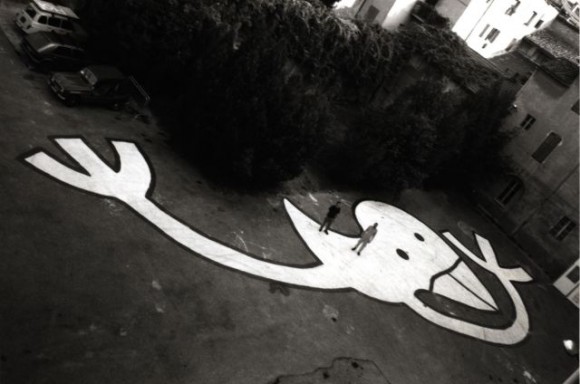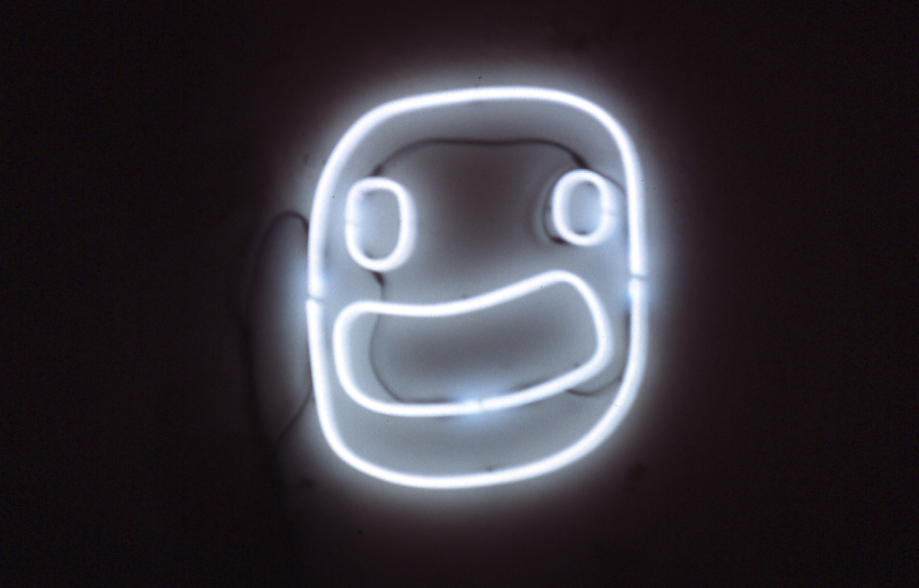![1990 p[2].](https://www.kainowska.com/sito/wp-content/uploads/2009/07/1990-p2.-.jpg) THE BIG GOOSE WITH PEABRAIN
THE BIG GOOSE WITH PEABRAIN
In the Nineties I was a teenager and, just as teenagers usually do, I used to think that the world was a very interesting place, all to discover. Those years were made of squats, lilac plush jackets, piercings, raves, crazy colours, playing hooky, striped shirts. During the transfers to Bologna in search of those things and of all the wonders they involved, I used to see a symbol repeated on the walls. It was not a more or less incomprehensible writer tag, but a drawing, very clear in its content. A sketch of a goose. A little birdie, which reminded me of my childhood cult book called Cipì[1]. It was repeated here and there, forming sometimes out-and-out tracks on the walls, like the pebbles in the Tom Thumb wood. It was traced with a childish stroke, very simple, it often had knobs on the cheeks, and long and loose legs. It was like a constellation: enigmatic, because it led to interrogate about its meaning and about the reason of its ubiquity, and powerful, because it was able to connect the childhood nostalgia to the longing for the next future. It was like a promise, of something beautiful and unknown that would happen very soon. I heard a lot of legends about this goose: “That’s a Jane Doe work. It’s a protest against stupidity in power and television.” “Yeah, I’ve heard that once she took a map of the city and drew a goose on it. Then she went to paint it on the walls according to the path on the map. It came out an enormous goose, visible from an aerial perspective, but also virtual at the same time.” Almost fifteen years have passed from that moment, but on an emotional level Peabrain will always be the symbol of my youth.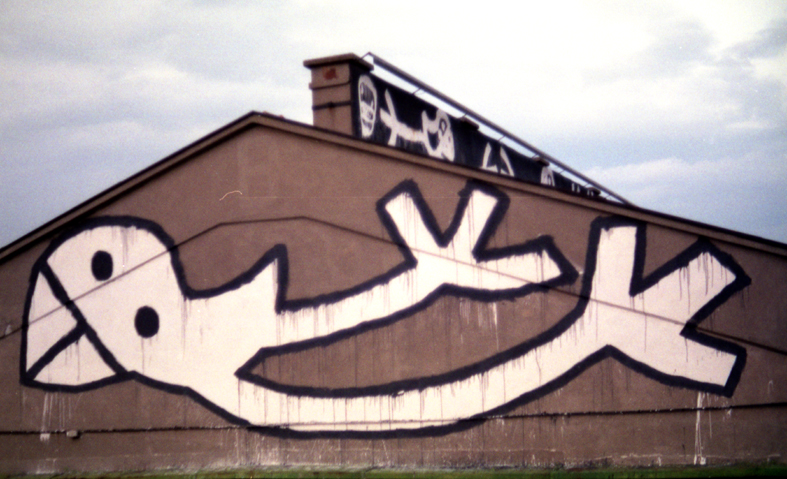
THE ARTIFICERS
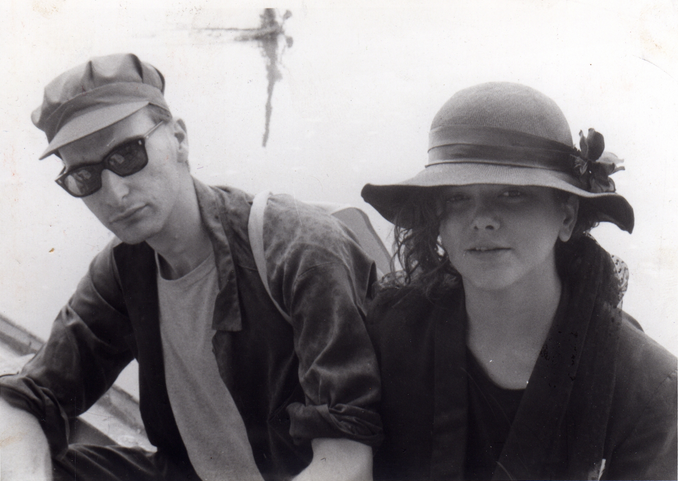 Monica Cuoghi and Claudio Corsello are two beautiful heads, wide open and tuned on frequencies which are very difficult to catch. Always in search of hidden paths, of places without official mapping, of interstices in ferment. Their art has been a thousand things: a way of taking back the city, a bow to the power of nature, an encrypted answer to the enigma of death. A play.
Monica Cuoghi and Claudio Corsello are two beautiful heads, wide open and tuned on frequencies which are very difficult to catch. Always in search of hidden paths, of places without official mapping, of interstices in ferment. Their art has been a thousand things: a way of taking back the city, a bow to the power of nature, an encrypted answer to the enigma of death. A play.
A way to pull their own legs. A poem for the beauty of places.
But, above all, a magical lifestyle, able to generate new realities.
The goose Peabrain is their most known interface.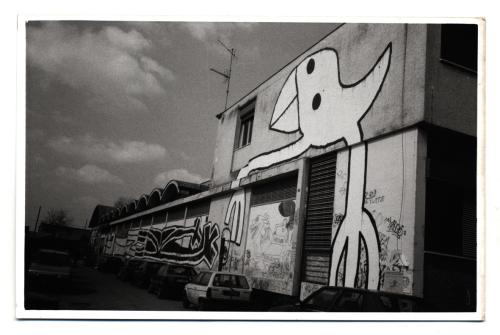
And Peabrain is only the tip of the iceberg. It came to light when Monica Cuoghi was twenty, but it arrived from an earlier time. Compulsion first: in the primary school little Monica passed her lesson-time drawing on the desks, so she also had to spent the playtime cleaning them up. In the middle school she changed her support, getting on from her desks to her arms, but the headmaster scolded her the same.
After compulsion, the form. In the high-school Monica used to draw elfish creatures, “little women inspired by the butterfly-women of Anna Chiavelli, between classic and Nordic fairytale. Slender as ants, black, with almond-shaped heads, and transparent, coloured wings”.
Then happened that all this potion, which had been simmering in the cauldron for years, alloyed and exploded in contact with the city context.
Monica Cuoghi: “First I had a great fun drawing many different things on the walls: a little horse, a little elephant, a grimace ,a table with the lamp and the chairs, the planets. Then a triangular little girl, with a spiralled head, and often with the pussy, from which vaginal humours and wee-wee came out. Peabrain was its simplified graphic form, more figurative. Synthetic, expressive, amorous, amused. Her appearance was instinctive, and also the choice that she had to be the protagonist on the walls, prevailing on the others.”
THE OPEN CITY
The city is fundamental for Cuoghi and Corsello’s project. The city is a net, it unites and pools people. It’s very ancient, it’s anchored to the present and it’s thrown to the future. It can be modified. 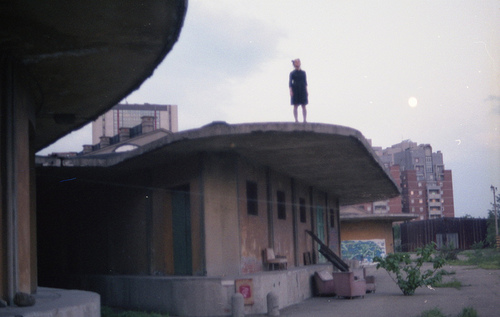 The city can be used to communicate. Politicians and big brands’ advertising men do that , so why its citizens can’t do it as well? A way of taking possession of the city is to draw on it, but it is also a way to give a gift to the citizens. A hand-made gift, something that haven’t existed before. As a gift, it doesn’t require anything in exchange for, no votes, no merchant worship neither. And who doesn’t like it, doesn’t deserve it. Due to the legislation which associates the unauthorized wall-painting with vandalism, writers live essentially by night.
The city can be used to communicate. Politicians and big brands’ advertising men do that , so why its citizens can’t do it as well? A way of taking possession of the city is to draw on it, but it is also a way to give a gift to the citizens. A hand-made gift, something that haven’t existed before. As a gift, it doesn’t require anything in exchange for, no votes, no merchant worship neither. And who doesn’t like it, doesn’t deserve it. Due to the legislation which associates the unauthorized wall-painting with vandalism, writers live essentially by night.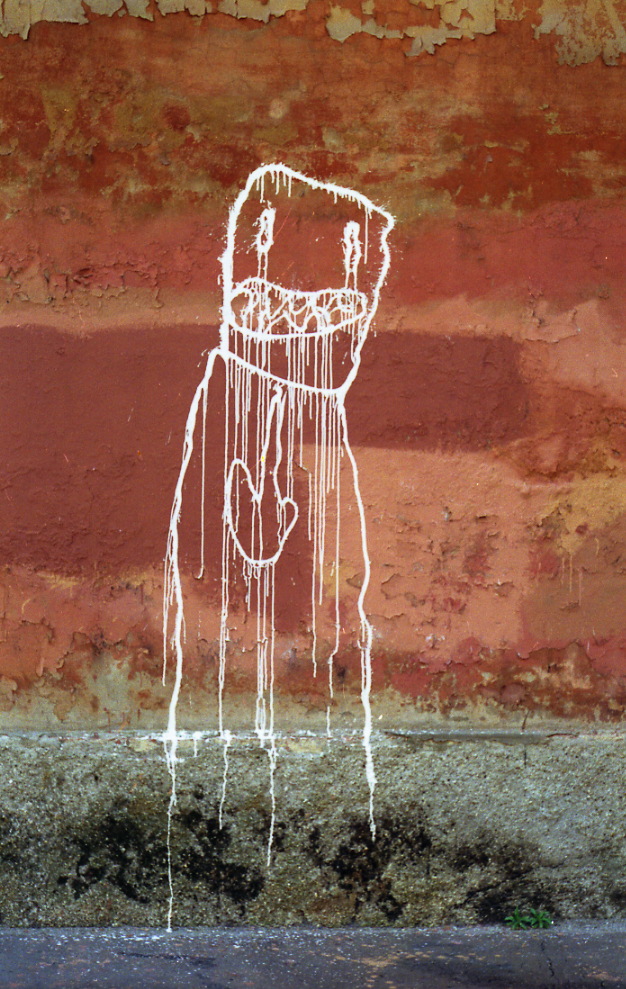
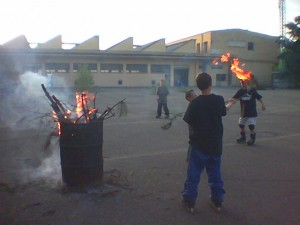 M.C: “Writing on the walls is a visual ri-appropriation of the city, of our places, of sources of knowledge and congregation fellowship. Yes! To fight the hypocrisy of the clean and tidy surface, where people leave wakes of dirty thoughts, people who are loosing their conscience, who are only able to defend themselves with their appearance. (…) The feeling which comes with the night excursions is beyond friendship and beyond the exciting match-play with your companions. It’s the embrace of the city: you feel like the more you look at it and draw on it, the more you love it. It’s a deep bond, which now is repaying me of all my sorrows, because I always meet young people who love Peabrain, and for whom it is an important benchmark and boost to their lives. I’m grateful for this, and I think that people feel and receive the love embrace carried by the sign. So I’ve though that maybe Peabrain is magical, that I was a link for bringing this beneficent sign to the people. Its two-dimensional look, its colour -black almost everytime- have something severe and important, something which came from I don’t know from where, forever. It’s Peabrain that has decided to arrive …”
M.C: “Writing on the walls is a visual ri-appropriation of the city, of our places, of sources of knowledge and congregation fellowship. Yes! To fight the hypocrisy of the clean and tidy surface, where people leave wakes of dirty thoughts, people who are loosing their conscience, who are only able to defend themselves with their appearance. (…) The feeling which comes with the night excursions is beyond friendship and beyond the exciting match-play with your companions. It’s the embrace of the city: you feel like the more you look at it and draw on it, the more you love it. It’s a deep bond, which now is repaying me of all my sorrows, because I always meet young people who love Peabrain, and for whom it is an important benchmark and boost to their lives. I’m grateful for this, and I think that people feel and receive the love embrace carried by the sign. So I’ve though that maybe Peabrain is magical, that I was a link for bringing this beneficent sign to the people. Its two-dimensional look, its colour -black almost everytime- have something severe and important, something which came from I don’t know from where, forever. It’s Peabrain that has decided to arrive …”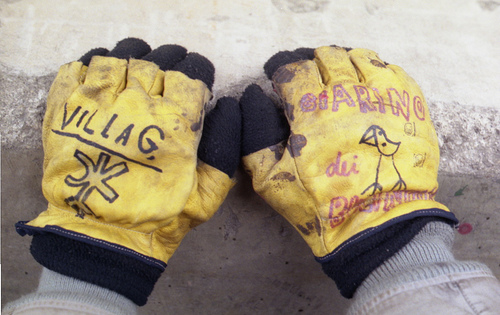
Claudio Corsello: We used to work on a trance, as possessed by a devastating divinity. Monica used to draw Peabrains without control. For example, if we were at a party, the walls would soon be set upon, creating often helter-skelter and horror. The manifestations of affection to Peabrain are always welcome, and they amaze me for their variety of feelings and suggestions. There is a great fantasy, P-lovers bring us satisfactions, even after a great deal of time since Monica has bombed the city. Everyone has a personal story to tell us. Love stories. Excepting those who wanted to hang us in Piazza Maggiore …”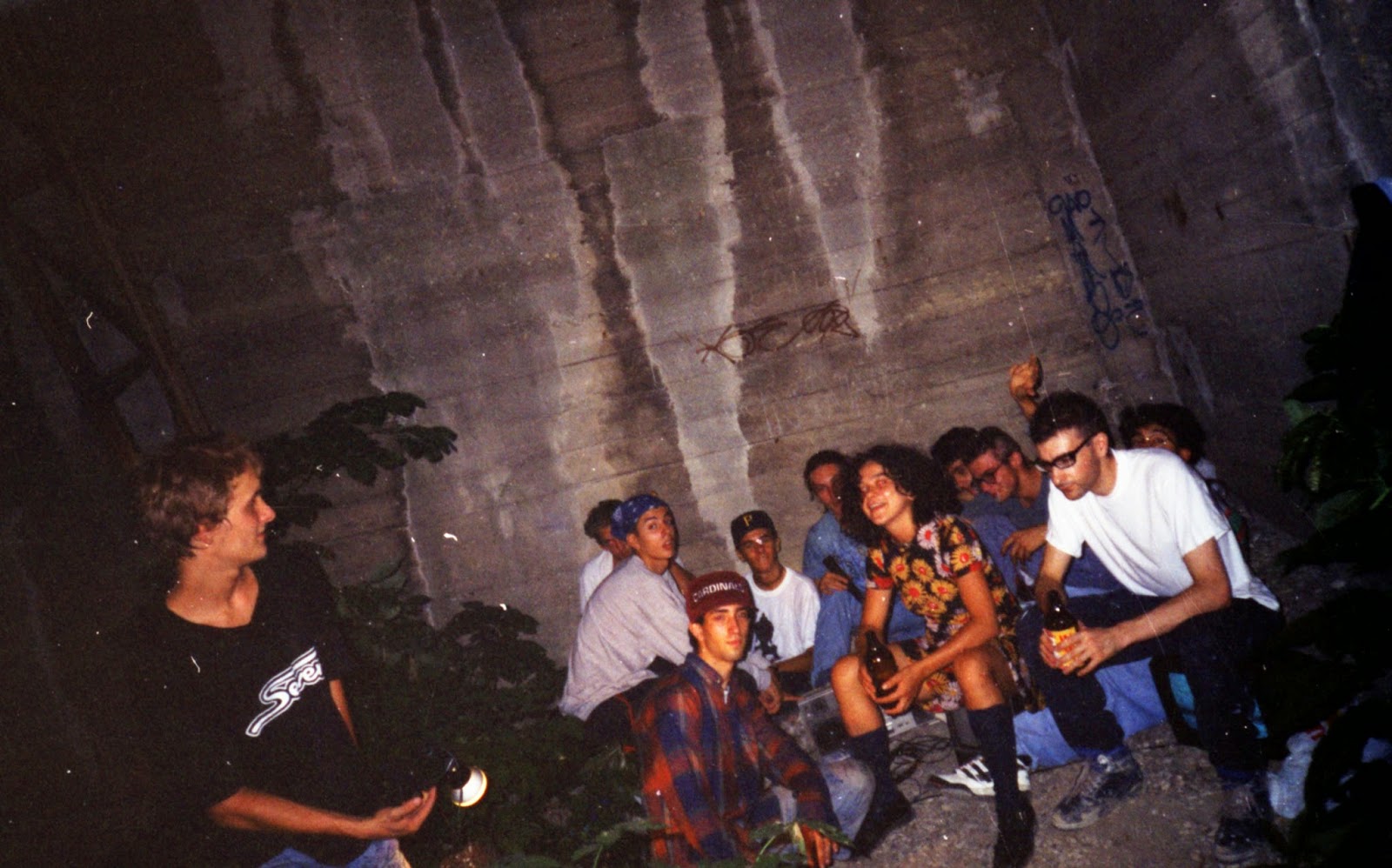
I‘ve also learned, during the Contemporary Art classes at DAMS in Bologna, that Peabrain did also a blue movie.
Monica recalls it this way:
“I graduated at the Academy of Fine Arts in Bologna, with a thesis entitled “Fluffy Cunt and Shaved Pussy go to the seaside”, made together with Simonetta Perlini. It was an edition of beautiful parts of blue movies, and black and white shootings of the city. It showed the society squalor as opposed to the pink sweetness of the blue movie. It was spaced out by elementary-written sentences, almost of them in a Dada style, and there was also a video-P.brain. There is also a condom-case of the ArciGay association, with instructions on how to use a condom, , and it features a big-penis Peabrain on it.”![4- 1994 petronilla n[1]. 1 bassorilievo di dash](https://www.kainowska.com/sito/wp-content/uploads/2009/07/4-1994-petronilla-n1.-1-bassorilievo-di-dash.jpg)
THE GOOSE’S NESTLING
Other creatures have been born from Peabrain, with a figurative parthenogenesis method.
For example Petronilla, “a kid with duck-hands, duck-legs and duck-head, and a big vagina as body. Three-dimensional, made of latex, gres, the first ones also of DAS.” (M.C.)
Then there is Cane Cotto (Cooked Dog), Claudio Corsello’s self-portrait. Monica defines it “a gnashing monster … self-critic or, better, self-flogging.”
Claudio says that “it dwells in the shadows and behind the corners, and if you turn the eyes you see it obliquely. It never looks you in the eyes, it never says hello-goodbye, and its distinctive quality is the ego-mania. Its byword is “If you did a tag today, it has not been a wasted day.”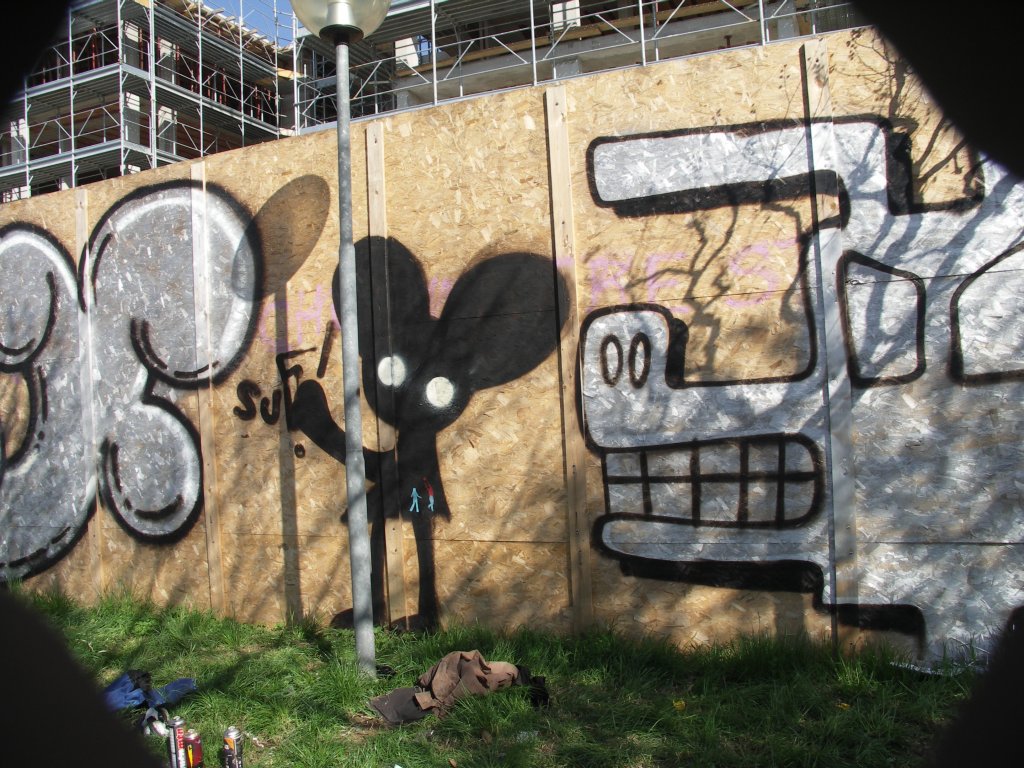
Then there is Bello “a sort of Cane Cotto but with the soft lines of Peabrain. It represents the classic. The beauty, harmonic and imperfect at the same time: as Venus, it disorients the sight.”
Suf has been born in 2000. A travelling-in-time soft-child, she can modify her own body as much as she likes. She has a skirt and Mickey-Mouse ears, and her name is the acronym for the Italian “Sono Un Folletto”, which means “I’m a pixie”. As every representation of childish figures, it is connected to the irrational, to talent and artistic inspiration, and also to the mythical past, in this case their past as writers.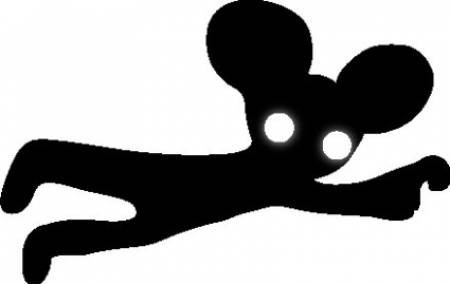
M.C.: “Suf has been born from the willing to learn something that I wasn’t able to do: I’ve decided to defy the writing world, to defy myself, because I’ve never been able to have a good relationship with letters and languages. My master Rusty used to say “suff(icient)”, and so I though “Here there is, I want to be at least sufficient in this discipline.” The puppet have been born a little time before: I finally want to make a girl, but she came out with those big ears, so I’ve thought that maybe she would become a musician. The most important thing of Suf is not the character, but the letters’ style, the writing, the bridge between art and writing. “I’m a pixie”, it was said by my girlfriend from Trento, in fact the Suf’s letters are convoluted as the world of nature. So: are the world of letters and the world of nature so different from each other? Are they opposite? The Abstract and the Pantheistic?”
Suf had transformed into a philosopher on the occasion of the Festival della Filosofia (Philosophy Festival) of 2008. Beginning from the acronym. “Sono un Folletto” becomes “Sono un Filosofo” (I’m a Philosopher): a great white head, suspended on the front of a Eighteenth Century palace in Sassuolo[2]. A head which would easily lift off, and get lost in the clouds, just as the thinkers use to do. It has big Mickey-Mouse-ears, to listen carefully to everything, and big black eyes, to look around. But it is without a mouth, because the last generation of philosophers doesn’t like chatting. Deleuze says that communication is persuasion, and it aims at consensus, whereas philosophy is concept, and is often more dissent than consent.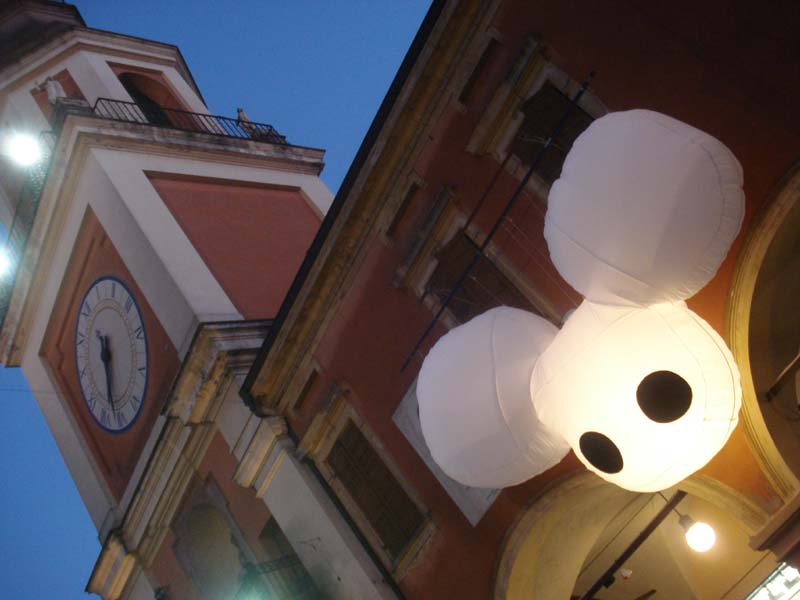 Suf also has a bad alter-ego, a little demon-brother named Skifio. It isn’t really evil, but it always swings between the good and evil polarities, and maybe it’s right
Suf also has a bad alter-ego, a little demon-brother named Skifio. It isn’t really evil, but it always swings between the good and evil polarities, and maybe it’s right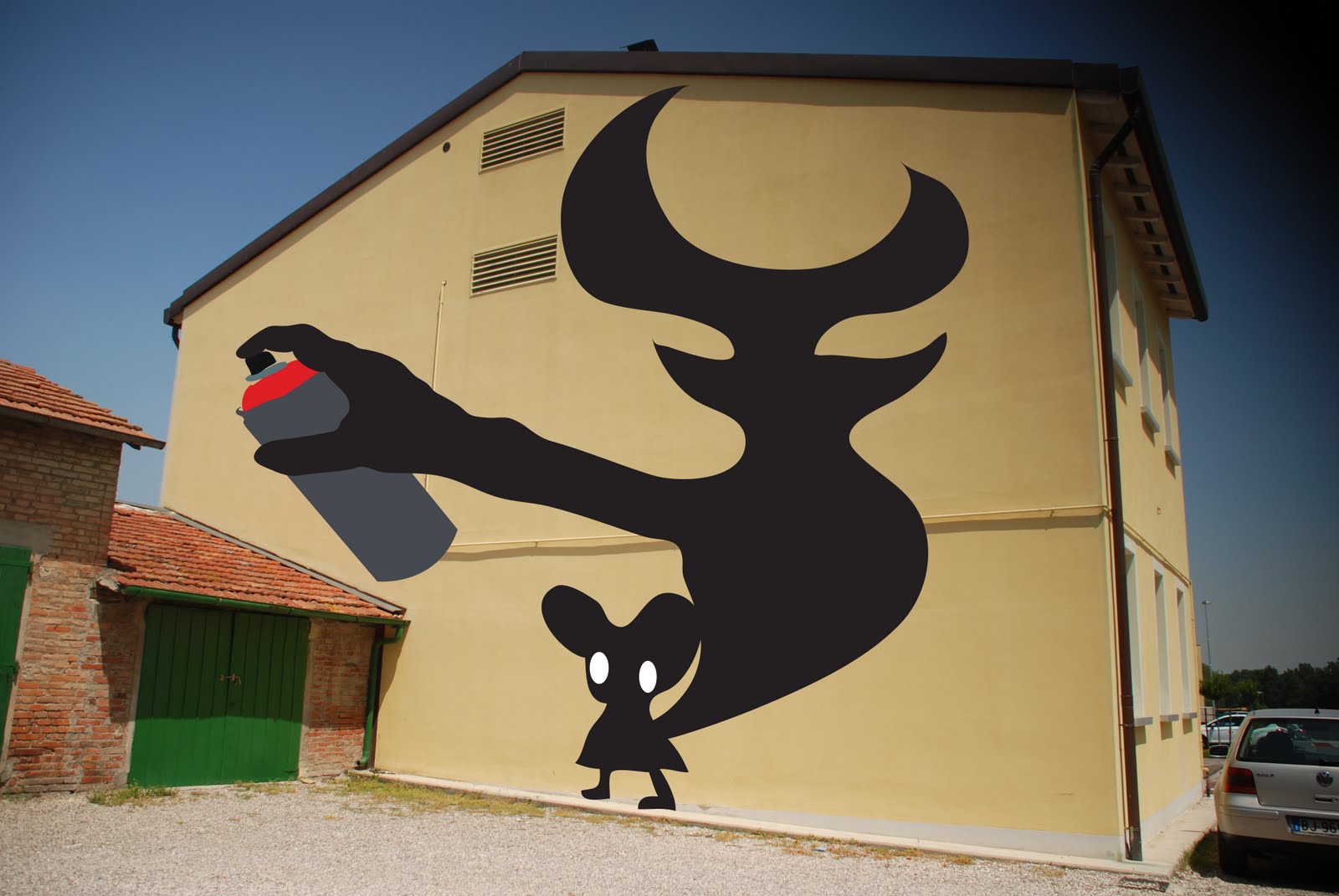
M.C.: “I have done a self-generating animation, in which many little Suf’s heads were at the window, and moved willy-nilly in the space, transforming from good to evil, like becoming demons. From good to evil, from evil to good… I was afraid of them, I was afraid that they would get into by the window. Then, my spiritual son Cap told me: “What’s that rubbish (schifio in Italian) that are you drawing?” And I replied : “Oh, you’re right! That’s the name: Skifio …” I grew an affection for it, and I realized that demons have the power of free will, to serve the good or the evil, just like men. So I wasn’t afraid of them anymore, and Skifio have become an important character.”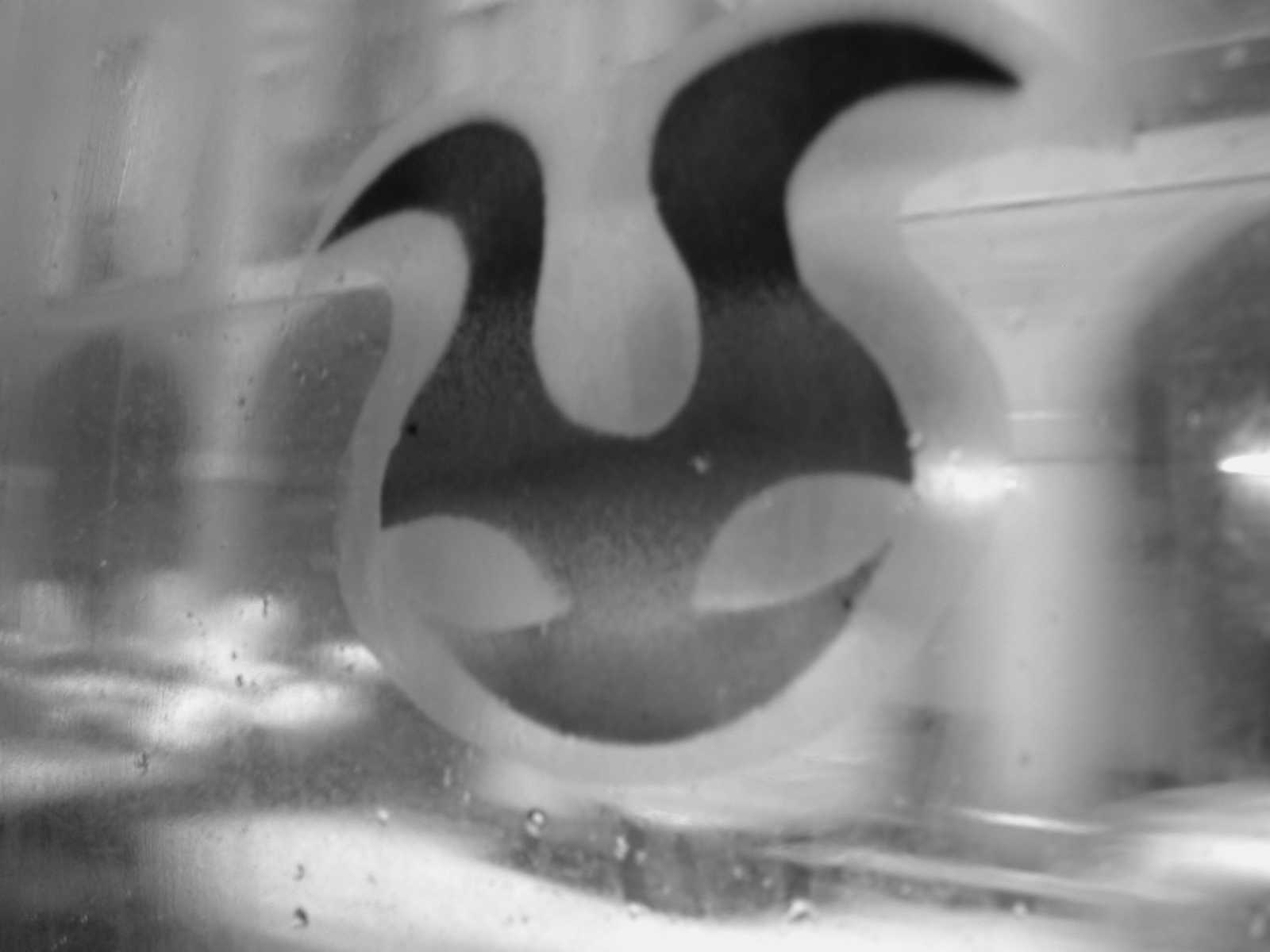
THE ENCHANTED CASTLES
Beside the visual bombing of the city, Monica Cuoghi and Claudio Corsello have begun to squat industrial parks during the years xy. The Garden of Bucintori, Gentian Manor, Wuthering Heights, FIAT. The squatting of factories becomes an artistic act, in which politics and aesthetics cohabit on equal rights. An artistic act once more bound to the city support.
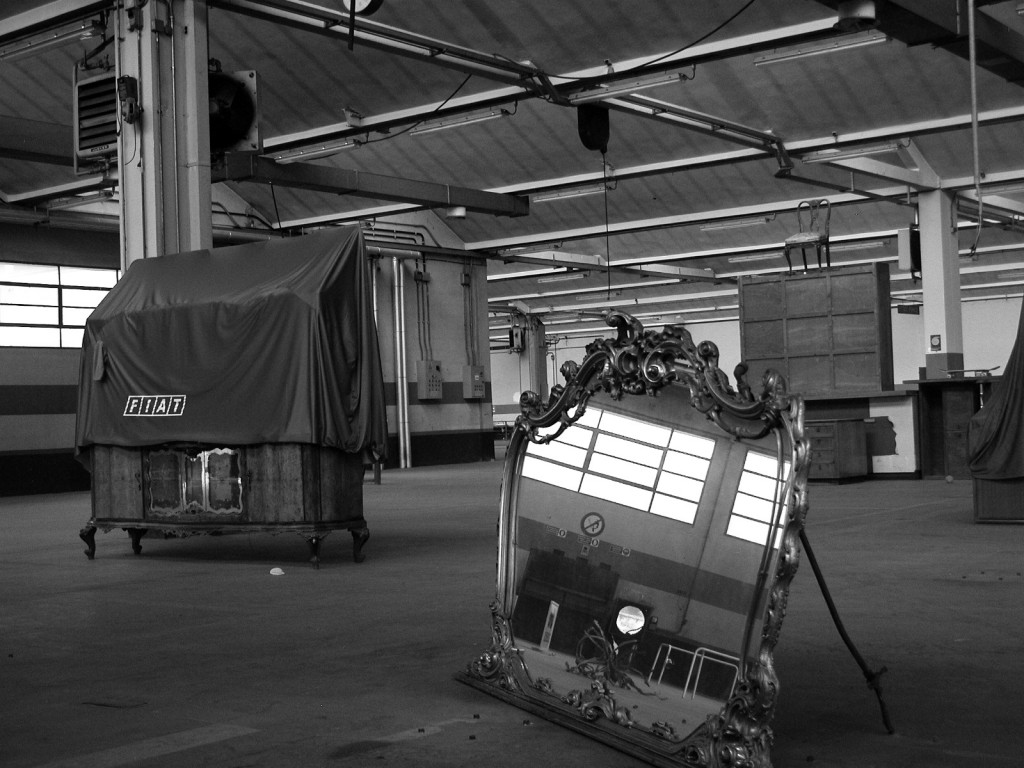 C.C.: “We have become squatters to live princely. Our factories were squatted in the sign of order and discipline. This is what you need to fight against normality.”
C.C.: “We have become squatters to live princely. Our factories were squatted in the sign of order and discipline. This is what you need to fight against normality.”
M.C.: “Squatting factories transformed daily life in an on-going installation. We composed everything, from stones, even our broom and dustpan. We tried to concentrate on everything as it would be the most important thing in the world. We began to understand the synchronic nature of events and to be less and less afraid of life. In the year 2001 we squatted the old FIAT factory in Bologna, after the experience at Wuthering Heights. So we integrated the abstract and severe FIAT style, with the one of Wuthering Heights, which was convoluted, bright, somewhat winter-garden and candles like.”
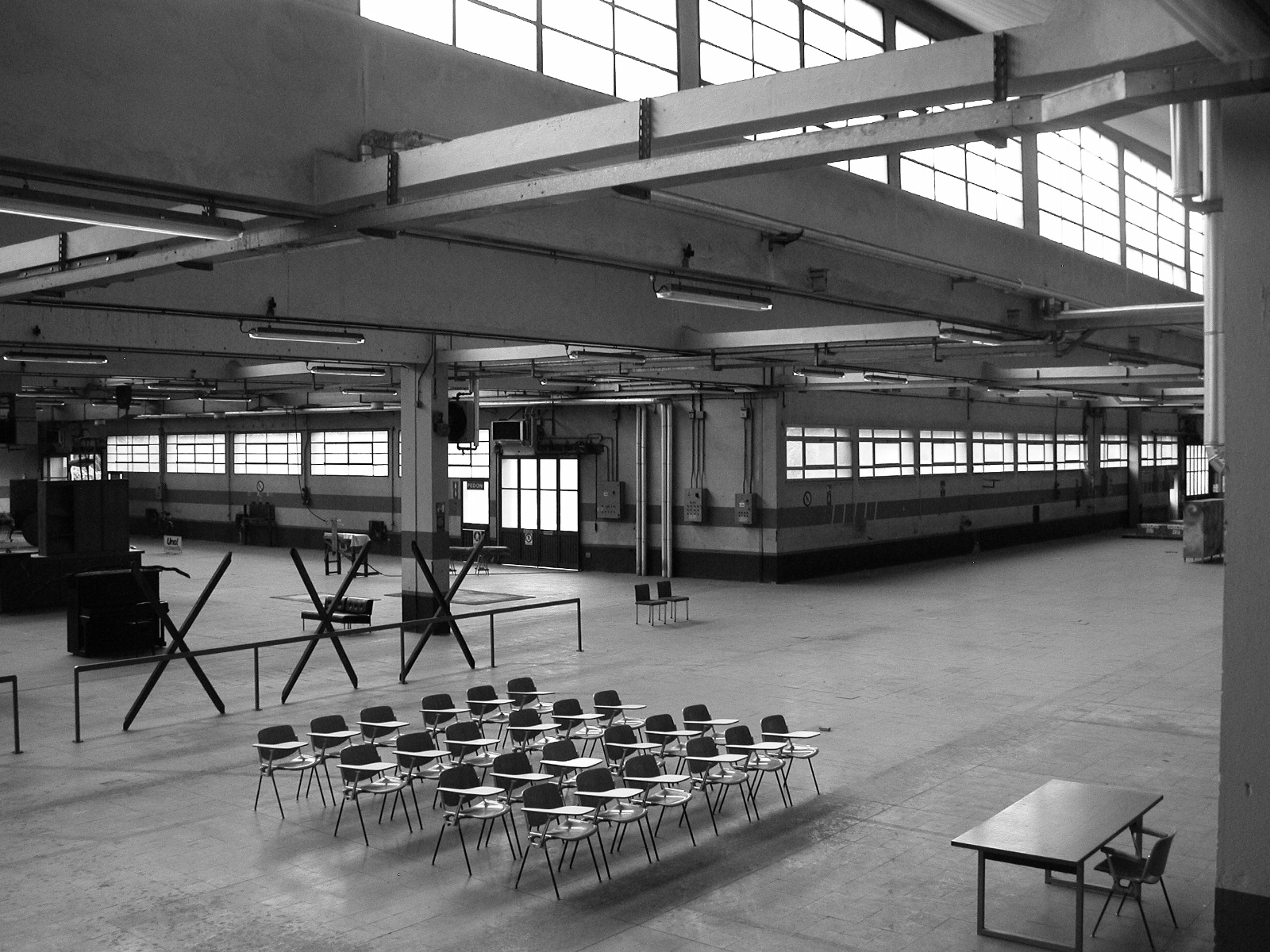 The factory appropriation stands out as an exorcism act. The cathedrals of weariness, of alienation, of exploitation, of atomization and expropriation of time are transformed in magical circles, in which beauty is the only rule. Temporary autonomous zones, in which there is always a party going on and in which everyone refuse the mechanistic principle of decryption of the universe, preferring the physical one, based on darts and fields of energy.
The factory appropriation stands out as an exorcism act. The cathedrals of weariness, of alienation, of exploitation, of atomization and expropriation of time are transformed in magical circles, in which beauty is the only rule. Temporary autonomous zones, in which there is always a party going on and in which everyone refuse the mechanistic principle of decryption of the universe, preferring the physical one, based on darts and fields of energy.
M.C.: “In big factories everything had its place and was energy free from oppressions. All the spatial relationships were created for pleasure or to express something. The pieces of furniture were creatures distant from the walls because the air had to turn around them, and it had to be free to dance everywhere. I used to sweep as a rite, creating spirals, and at the end I tallied up the little bunches guessing a mantica for the space, or for the condition of events. I moved pieces of furniture, lights, trunks, dollies, sofas, and almost the walls, composing and breaking up them to understand and find out the right position, which was changing during the time. Claudio loosed his patience sometimes and left me alone in the craziness of composition, and so I was incredibly able to move wardrobes, sideboards, cellophane houses. Unimaginable things. The strength you get when you have faith in intentions is incredible.”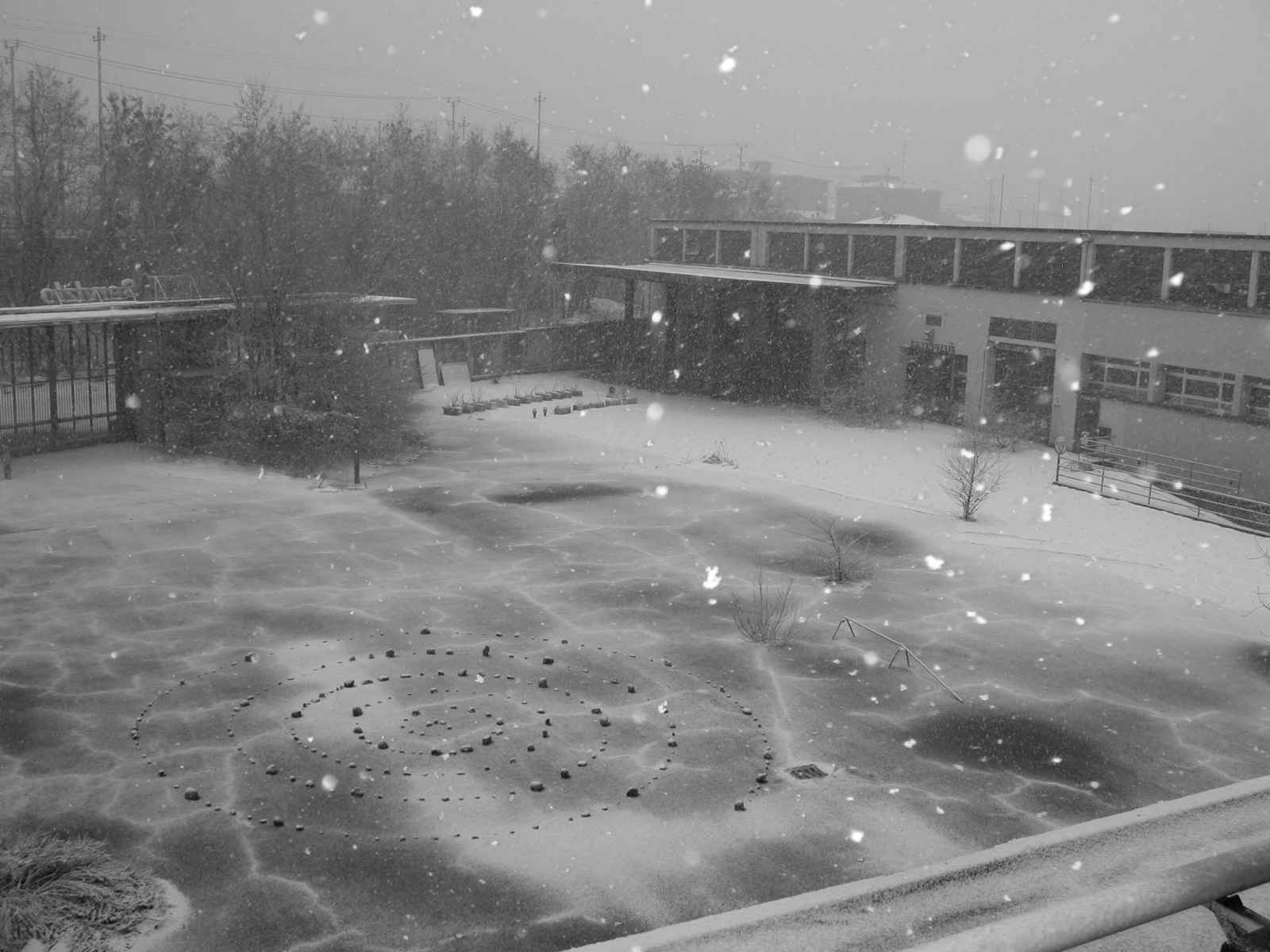
SPACE CURE
The ritual intervention on environment, in order to displace electronic fluxes and energy fields, is a constant feature in Cuoghi and Corsello’s work. Art as an intervention to set things right, as a re-mapping of reality. We can consider by this point of view also the see-through sculpures-theatres, settings made of cellophane, which delimit immaterial rooms, with demi-invisible walls. These works are rebuild each winter, as glasshouses, or fairytale houses with ice walls. 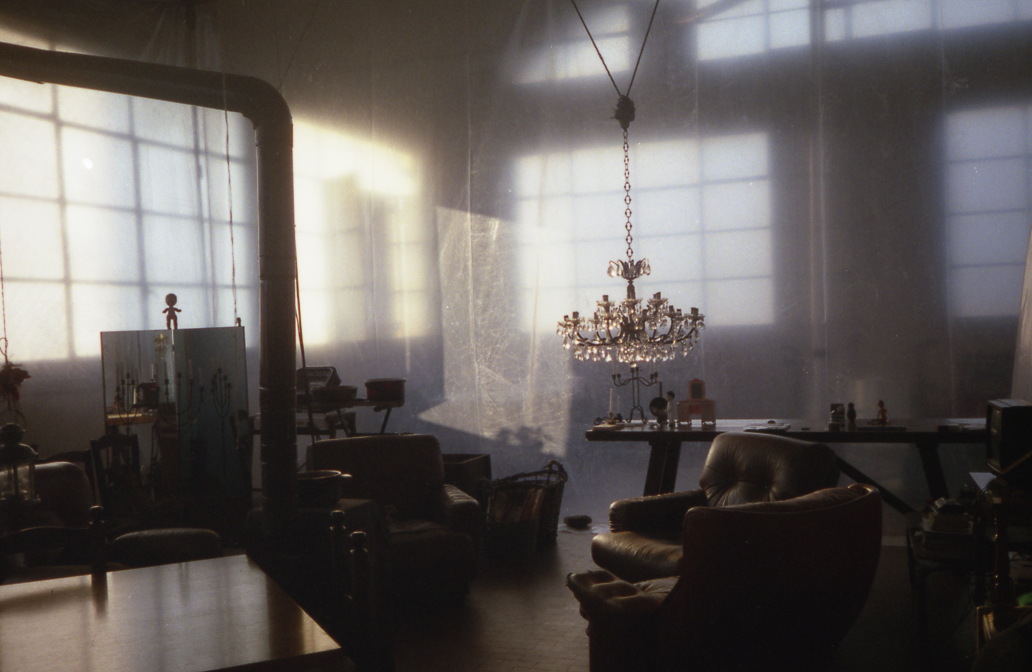 M.C.: “The big hall (40 metres for 20) which hosted the houses-sculptures made of cellophane was named Chandelier, for the first object placed in it, a big swinging lamp with crystal drops. This hall looked like a square, it was surrounded by big windows on its perimeter, and trees and ivy protected the place like in the Snow White castle. It seemed a dream. Here took place the daily repeat of an eternal performance: the life, the red of the sunset which flooded it with the coloured candles. It was very evocative.”
M.C.: “The big hall (40 metres for 20) which hosted the houses-sculptures made of cellophane was named Chandelier, for the first object placed in it, a big swinging lamp with crystal drops. This hall looked like a square, it was surrounded by big windows on its perimeter, and trees and ivy protected the place like in the Snow White castle. It seemed a dream. Here took place the daily repeat of an eternal performance: the life, the red of the sunset which flooded it with the coloured candles. It was very evocative.”
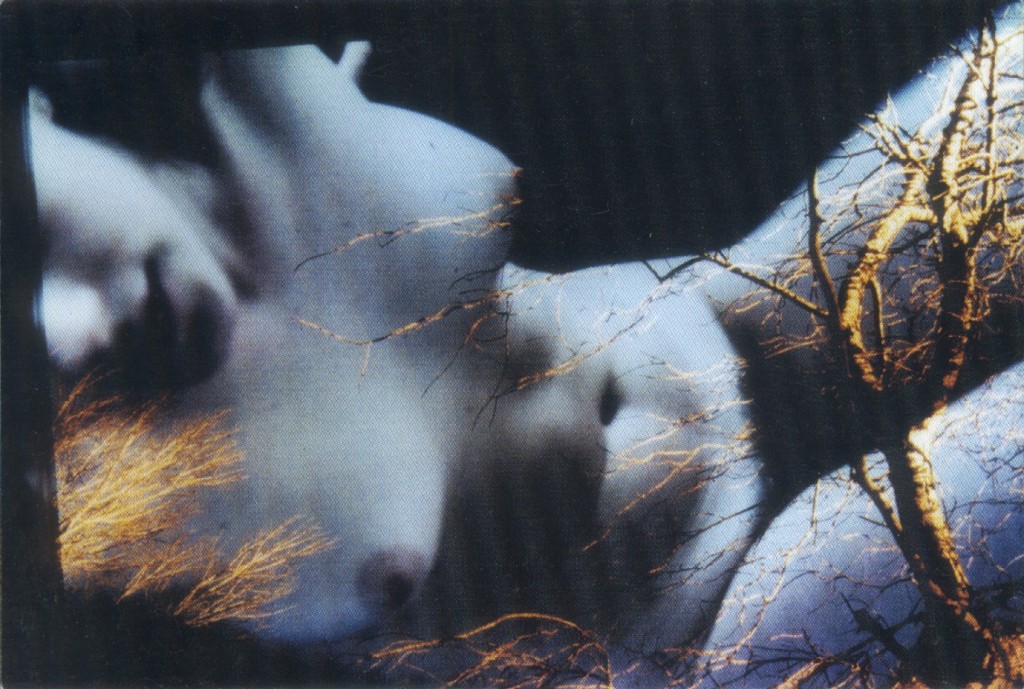 The installation The Spirit of the Girls, presented in 1999 for the exhibition Tucsia Electa, Cuoghi and Corsello set up an artificial flooding into the cellar of a palace of the Fifteenth Century. They upholstered the building with black plastic material, until the wanted level, and they made the water flow with a system of pumps. The viewers passed on gangways made of aluminium. “A video screening, was simulating the spirit of the girls, in the meantime. It got up from the water and prostrated, waving the hips and the arms, and then suddenly it disappeared in the wall.” (M.C.)
The installation The Spirit of the Girls, presented in 1999 for the exhibition Tucsia Electa, Cuoghi and Corsello set up an artificial flooding into the cellar of a palace of the Fifteenth Century. They upholstered the building with black plastic material, until the wanted level, and they made the water flow with a system of pumps. The viewers passed on gangways made of aluminium. “A video screening, was simulating the spirit of the girls, in the meantime. It got up from the water and prostrated, waving the hips and the arms, and then suddenly it disappeared in the wall.” (M.C.)
The Blue Tree is dedicated to the city and to the magic intervention on its habitat. It was painted in conjunction with the last local council election, when it seemed that a new political season was about to happen in Bologna.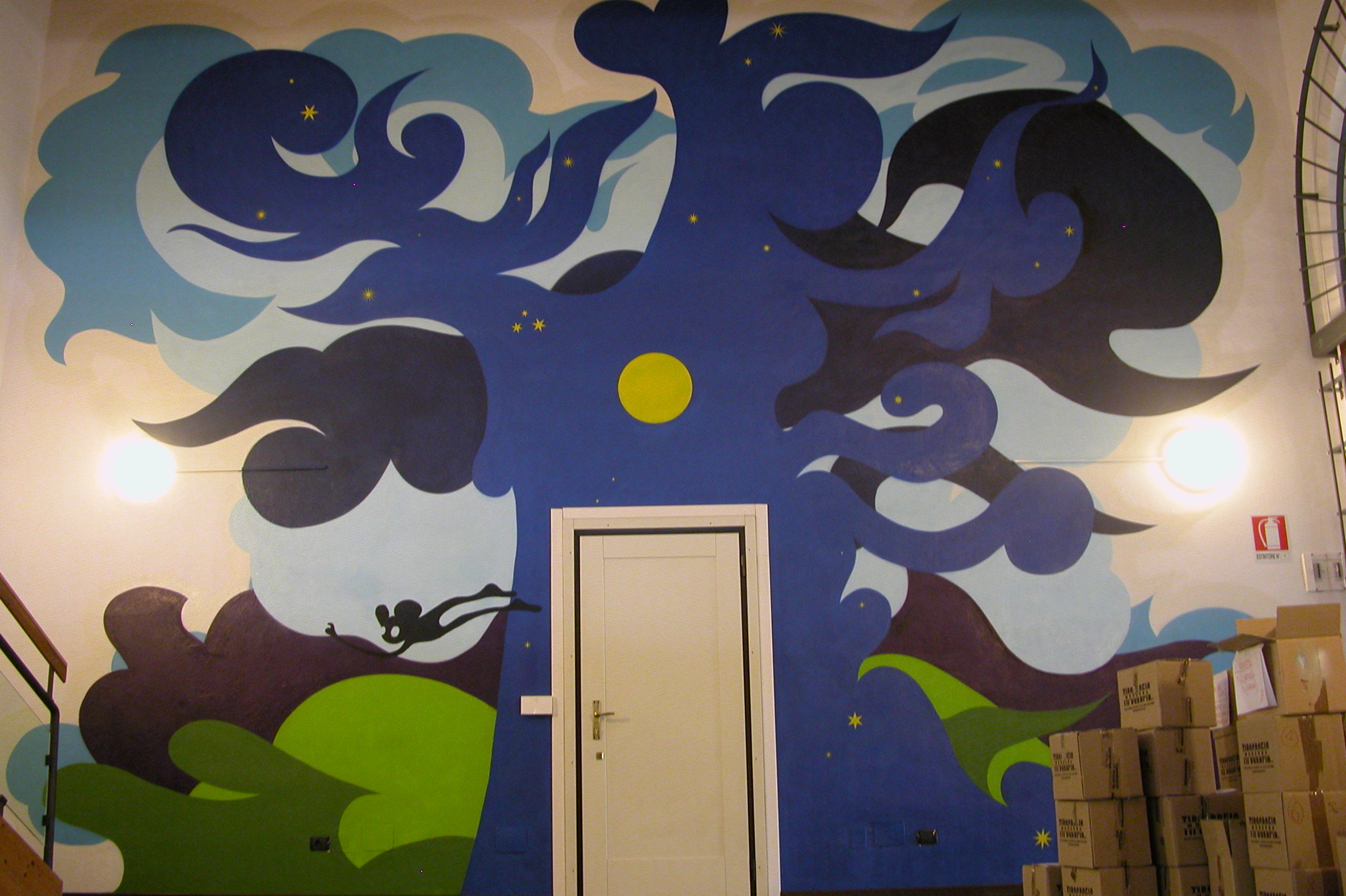
M.C.: “It was meant to be a door for a new season of the city. The blue tree with the stars and the moon represented the knowledge of the not integrated part of this society: the night, femininity, the occult. The tree was an invitation towards the ancient knowledge of every Art, to a revival to unite sciences and different cultures, the return of Frederick II, Holy Roman Emperor”
THE FEMALE-TREE
The tree is a very ancient symbol, it’s the symbol of the earlier religion, and it has the same meaning of the cross and of the shield of David. It connects what stands above with what stands below, and harmonizes the opposing dichotomy. It’s the emblem of the power of nature.
![2000 mobile n[1].6 tavolo giardino scultura](https://www.kainowska.com/sito/wp-content/uploads/2009/07/2000-mobile-n1.6-tavolo-giardino-scultura.jpg) To these topics also the sculpture Garden-Desk is connected, an old Chippendale coffee-table, on which Monica has worked every day, collocating on it clods picked up in the garden. The process has been long, and integrated with a complex system of irrigation. After a while the grass has grown on it, and some lilies have sprung out at the centre of it. Spontaneously. The nature, the chance, what is traditionally without thought and intentionality united with a surprising formal harmony to the curve and woody lines of the coffee table. Culture and nature have collaborated to create a living, interactive piece of art, which needs constant cures to keep its beauty.
To these topics also the sculpture Garden-Desk is connected, an old Chippendale coffee-table, on which Monica has worked every day, collocating on it clods picked up in the garden. The process has been long, and integrated with a complex system of irrigation. After a while the grass has grown on it, and some lilies have sprung out at the centre of it. Spontaneously. The nature, the chance, what is traditionally without thought and intentionality united with a surprising formal harmony to the curve and woody lines of the coffee table. Culture and nature have collaborated to create a living, interactive piece of art, which needs constant cures to keep its beauty.
The Breathing Wood is an environmental installation of singular suggestion, which was realized for the exhibition “Under Pressure”at Bovisa in Milan. A hymn to life and light, to the connection between us and the world. The element on which the work is based is the blow, the spirit. Our breath, and the one of all the living beings. The butterfly-winged Psychè, the female Ruah, exactly the one which was wafting over the waters before the God of the Old Testament took the fancy of creating the world.
M.C.: “We had installed big beacons in the middle of a wood nearby the former gasometer of Milan. They were illuminating the wood from below. A junction box made the lights rise and dim, as a deep breath rhythm: six seconds up, three seconds turn on, six second down, three seconds turn off. And then again, giving a sense of a deep, leafy breath.”
FIAT LUX
Maybe it sounds funny to say that one of Cuoghi and Corsello’s favourite material is light. Funny because light is immaterial. It can’t be touched, nevertheless it’s strongly needed element, as in Arts as in the world. A lightless world would be a dead one. Using light in Art is, once more, a marvellous way to make the opposite couples compenetrate each other. Light and darkness, matter and spirit, fear and hope, and the list could go on forever.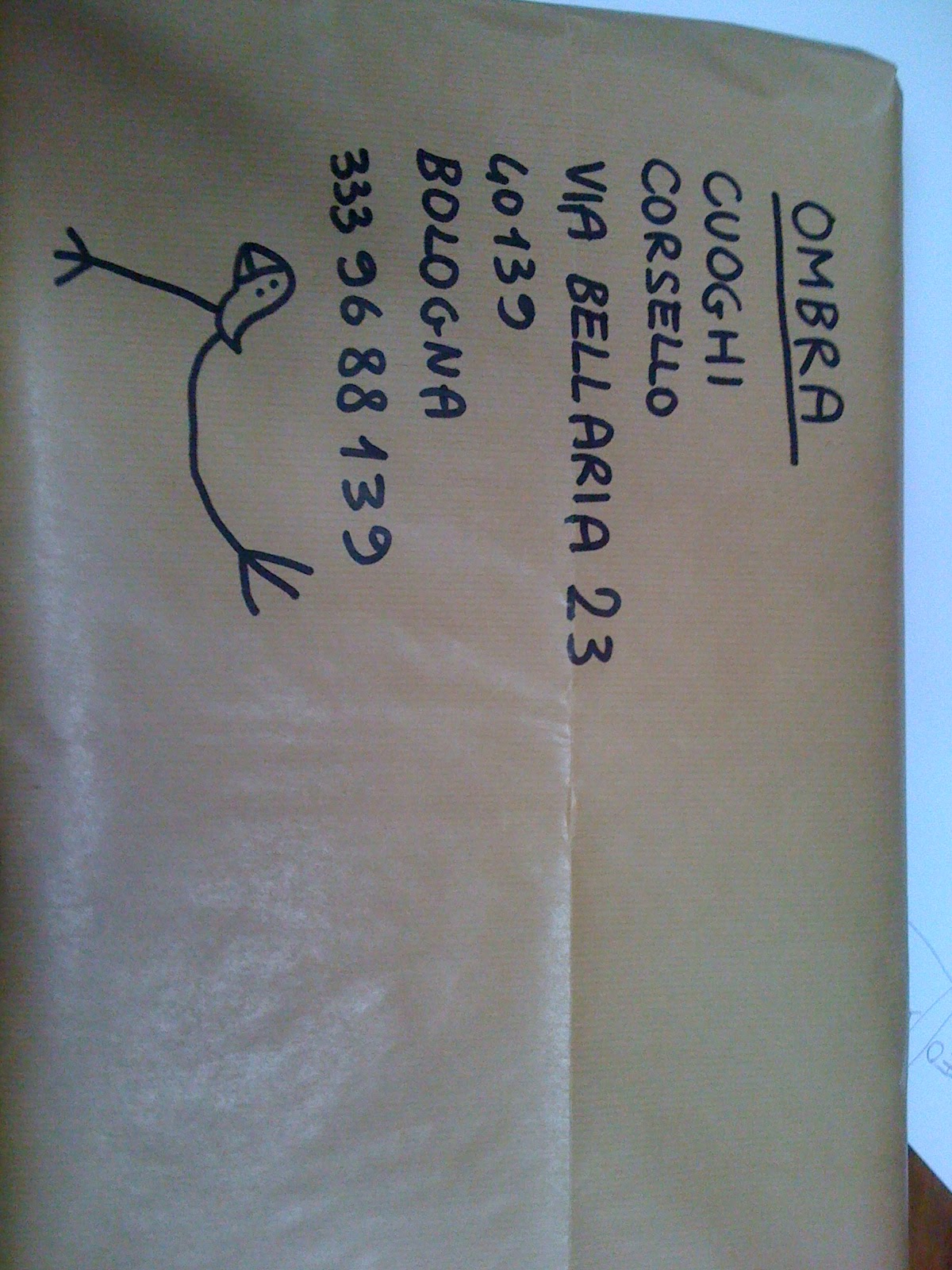
We can mention the installation Shadow, in 1996, for the exhibition Antico Contemporaneo in Bentivoglio (Bologna Province).
M.C.: “A metal structure made the doll Shadow move, from right to left, from left to right. The structure moved also a beacon behind the doll. The beacon was directed on the doll and projected it, big, on the castle. Her keen little body and her raised arms were moving softly, from right to left, from left to right, as a Pope, welcoming the audience. Four blue rotating police beacons bordered the work in the garden.”
Many more works were realized in the sign of light. The neon sculpture Bello, 1996, for the exhibition Martyrs and Saints, in the gallery L’Attico, in Rome, in which “the transformer with a lower power makes it tremble as an old neon-light. A lot of time has passed, but (it is still working) this way.” (M.C.)
The Suf Light-Box, for the exhibition Chiarimenti (Enlightments) in Chiari (Brescia Province), in which, in the black Suf’s head, there were a couple of big eyes turning on and switching off softly “like the Mac’s little stand-by light”
And also the performance The Resurrection of Petronilla, made in the town of Bagnacavallo near Ravenna, in the occasion of a town festival. Cuoghi and Corsello appropriated of a dismissed hotel, Il Nano (The Dwarf), and painted it of dark pink. Then they painted a big Petronilla’s shape in the front of it, with a transparent and fluorescent pigment. Finally they retreated into a hidden room of the hotel, playing the same song all night long, a march for the resurrection of Petronilla. “A timer was interchanging the light and the darkness: when the light was on the people can see the empty pink hotel, when the light was off the luminous Petronilla appeared. The people which were there in the moment of darkness had to cross a long blind corridor to reach the hall with Petronilla. The event organizer told us that, making the local people face the fear of darkness and undergo the proof of crossing the corridor, we had defeated an ancient curse hanging on the town. The town festival was made to exorcise the curse.” (M.C.)
THE FAIRYTALE MORPHOLOGY AND THE SYNCRONICITY THEORY
Another very important work of Cuoghi and Corsello is connected to this dimension of magical rite. It is the installation Eleonora’s Birthday Party, realized in 1987 for the exhibition Traviata in the Boschina island of Ostiglia. The island’s shape was similar to a triangle, and there was a triangular field in the middle of it, with a circle of very tall trees. Monica Cuoghi suspended there eight swings, with their seats made of wood, and very very long rusty chains. To each swing there was attached a double photograph, with two little girls.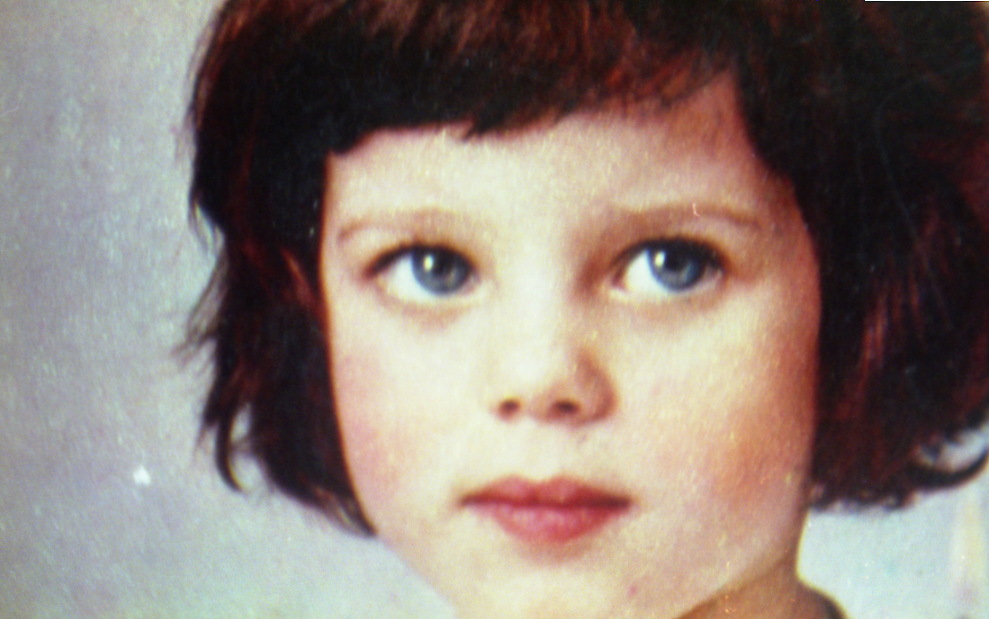
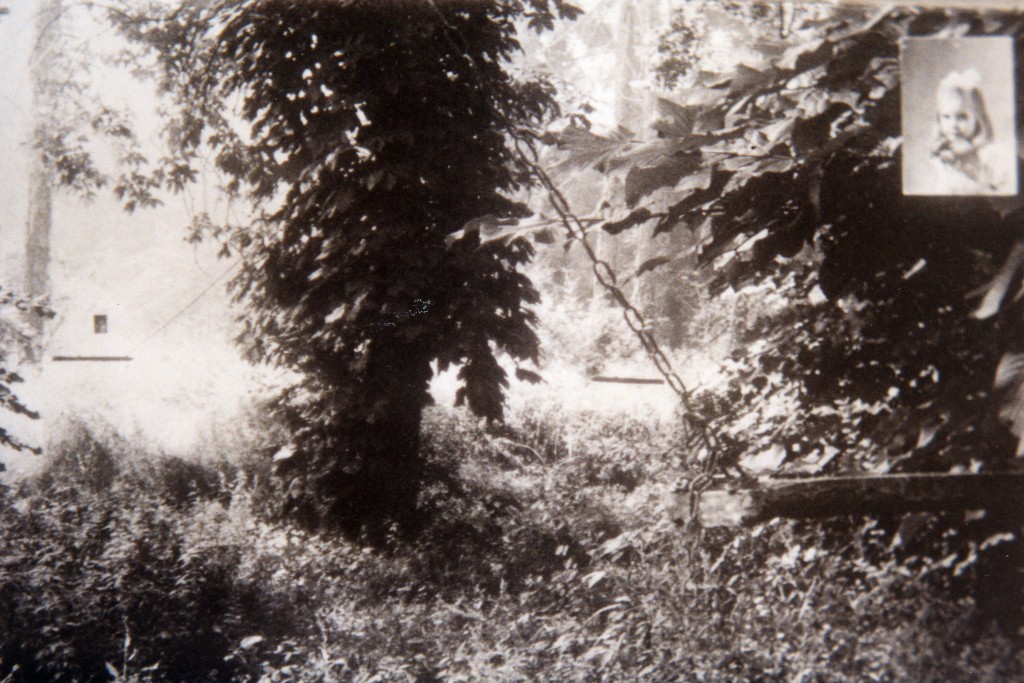
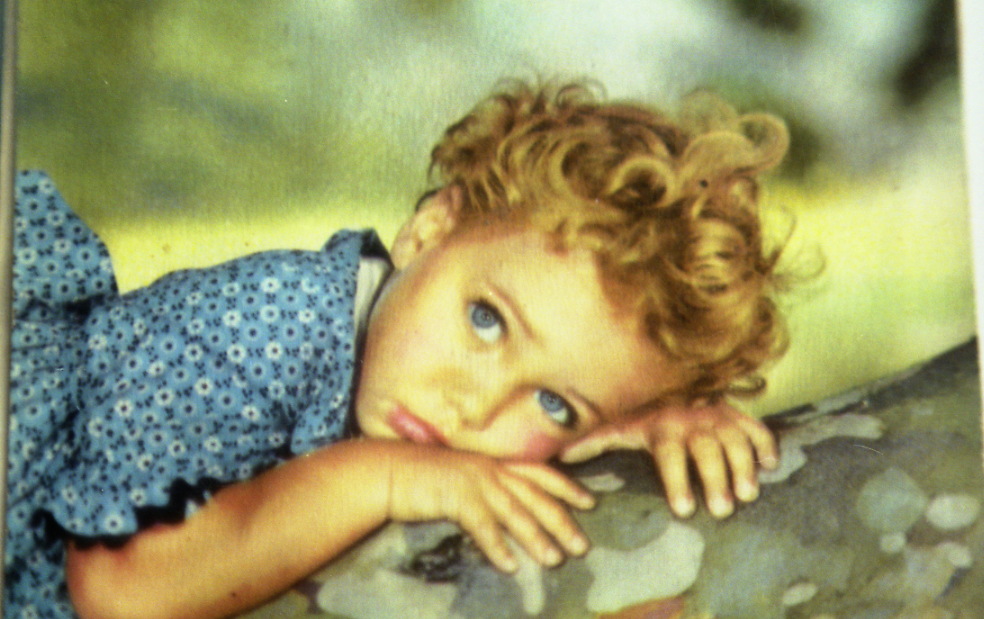 “It was the Eleonora’s birthday party, and she had died that day. If you were standing in the middle of the circle, you could feel a very strong and peculiar feeling. Indescribable. Inside and outside the circle there were two different worlds, two different levels of perception. After a long time I’ve discovered that the two girls in each swing, interchanging themselves according to the wind, were one good and one evil. When I installed The birthday party of Eleonora I realized that the artist is an interpreter of the magical and subtle world, and he/she understands him/herself and the life through art.”
“It was the Eleonora’s birthday party, and she had died that day. If you were standing in the middle of the circle, you could feel a very strong and peculiar feeling. Indescribable. Inside and outside the circle there were two different worlds, two different levels of perception. After a long time I’ve discovered that the two girls in each swing, interchanging themselves according to the wind, were one good and one evil. When I installed The birthday party of Eleonora I realized that the artist is an interpreter of the magical and subtle world, and he/she understands him/herself and the life through art.”
Ten years after, the installation Plane Crash displayed the same fairytale atmosphere. 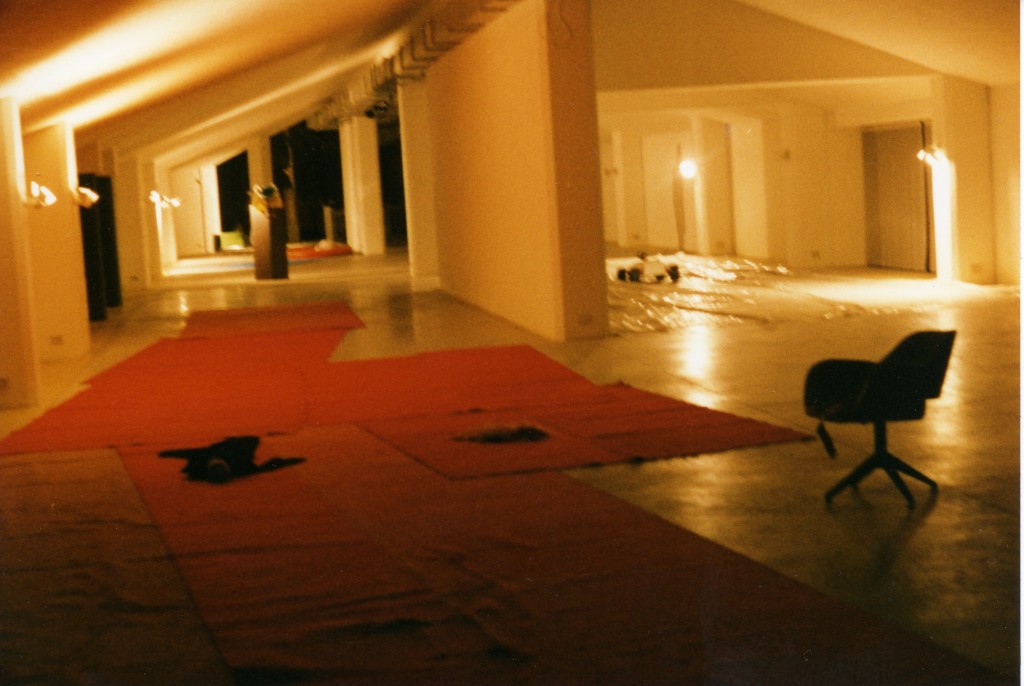 “Big red fitted and disconnected carpets were simulating the uprooted runway. Cicciodoro was dressed with a tuxedo too long for him, and laid on the floor playing the death newly-wed, his red wig some meters by him. The American kid who was playing the white-dressed bride, looked dazed as perceiving the disaster. Near the bride there were her friends, the pig and the rabbit. A inflatable swimming-pool, placed on a green carpet, hosted a pink walrus, and the water was springing from his belly as from a fountain. Before the uprooted runaway there was a Seventies piece of furniture, with a rabbit dressed with the airplane’s lifejacket, looking down with astonishment, and a not working red alarm clock in the shelf under.”
“Big red fitted and disconnected carpets were simulating the uprooted runway. Cicciodoro was dressed with a tuxedo too long for him, and laid on the floor playing the death newly-wed, his red wig some meters by him. The American kid who was playing the white-dressed bride, looked dazed as perceiving the disaster. Near the bride there were her friends, the pig and the rabbit. A inflatable swimming-pool, placed on a green carpet, hosted a pink walrus, and the water was springing from his belly as from a fountain. Before the uprooted runaway there was a Seventies piece of furniture, with a rabbit dressed with the airplane’s lifejacket, looking down with astonishment, and a not working red alarm clock in the shelf under.”
Childhood appeal is clear in this scenario, which seems the illustration of a fairytale book. The same that we can find in every iconic creatures of Cuoghi and Corsello, from Peabrain to Suf, in the installation The Birthday Party of Eleonora, in the doll Shadow. Childhood, seen as a magical place of endless possibilities. Other age par excellence, capable of seeing the world much better than we usually do. Able to understand intuitively the syncronicity theory.
M.C.: “I exhibited the sculpture/composition with my old teddy-bears Aldos in 1996, for the exhibition Pop Planet in the THE gallery, in Naples. When I was a kid, I used to imitate my friend Marco, and for this reason all my teddy-bears were named Aldo. Then, when I was in New York, I’ve bought a teddy bear from a little girl, for five dollars. Finally a teddy bear whose name was not Aldo, but Dakin! When I came back to Italy, the day after, I got paid 5 millions liras for my teddy bears.”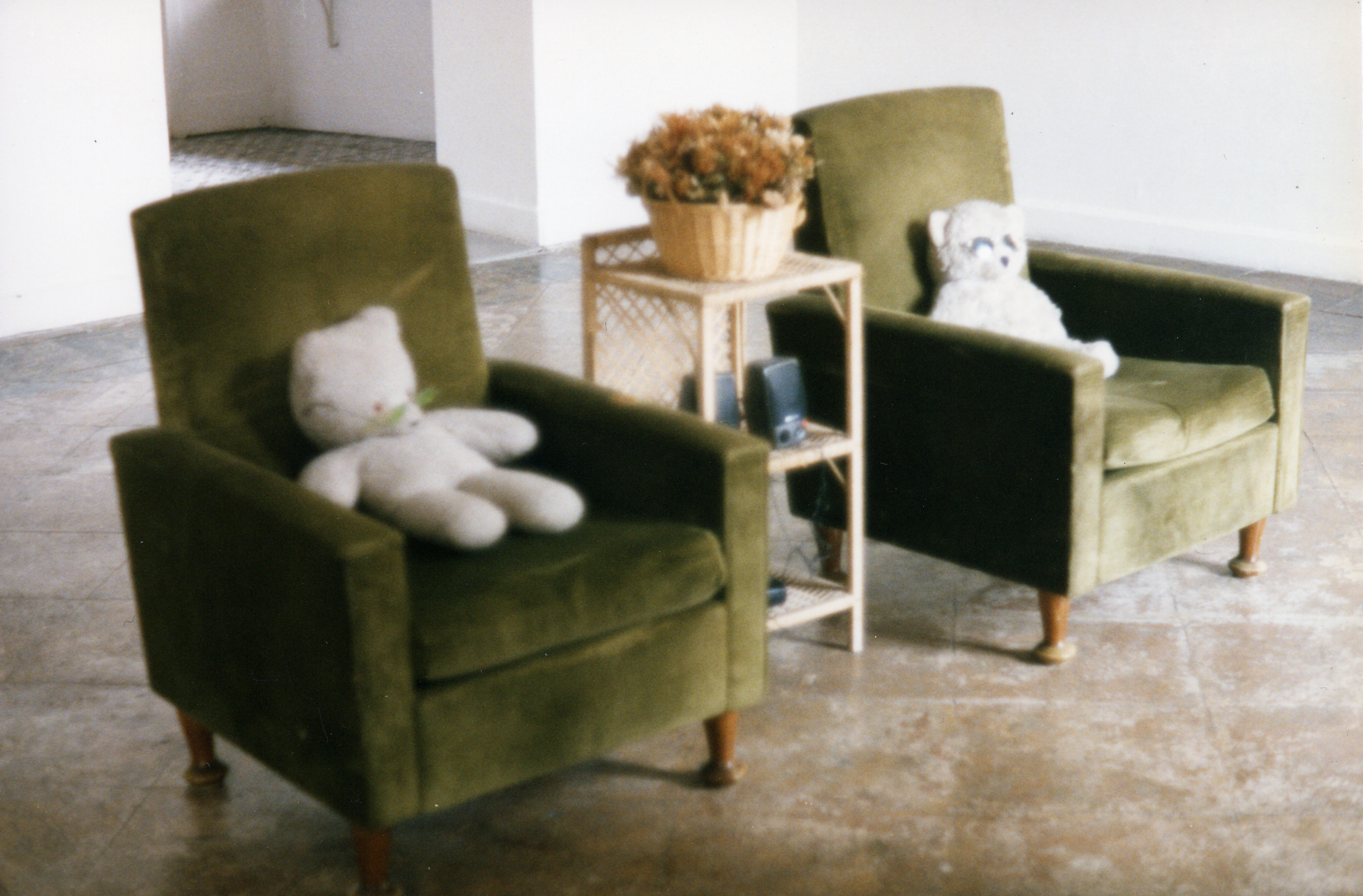
NEW STRUCTURES OF THOUGHT
When I write about an artist, I try to proceed by connections. In the work of Cuoghi and Corsello the bridges between an element and another are manifold. For this reason the structure of their way of working is similar to a rhizome, a little root with an endless network of interconnected micro-channels. The same configuration of the labyrinth, which was represented as a spiral in the beginning of civilization. And the spiral recurs here and there in the work and in the words of Cuoghi and Corsello. The spiral, the symbolic form of contemporary arts, that is to say its most representative symbol. The spiral, the rhizome, the net, are all splendid on a formal level, but they are also symbols of knowledge of very high density.
Under its naïf mask, the work of Cuoghi and Corsello is able to be archaic, classic, and post-modern at the same time. Synchronically.